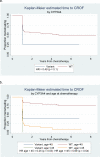Association of cyclophosphamide drug-metabolizing enzyme polymorphisms and chemotherapy-related ovarian failure in breast cancer survivors
- PMID: 19376514
- PMCID: PMC2891284
- DOI: 10.1016/j.fertnstert.2009.03.034
Association of cyclophosphamide drug-metabolizing enzyme polymorphisms and chemotherapy-related ovarian failure in breast cancer survivors
Abstract
Objective: To determine if genetic variation in chemotherapy metabolism are associated with risk of ovarian failure in breast cancer patients after adjuvant chemotherapy.
Design: Prospective cohort study.
Setting: Comprehensive cancer center.
Patient(s): Early-stage breast cancer patients who were premenopausal at cancer diagnosis and treatment.
Intervention(s): None.
Main outcomes measure(s): Chemotherapy-related ovarian failure (CROF).
Result(s): A total of 127 breast cancer subjects who were premenopausal at cancer diagnosis and underwent cyclophosphamide-based chemotherapy were genotyped for nine single-nucleotide polymorphisms (SNPs) in enzymes involved in cyclophosphamide activation (CYP3A4, CYP2B6, CYP3A5) and detoxification (GSTA1, GSTM1, GSTP1, GSTT1). Median age at chemotherapy was 43.2 years. Median follow-up after chemotherapy was 5.2 years. For the entire cohort, there was no significant association between CROF and SNPs. However, the association between CROF and SNPs was modified by age at chemotherapy. In subjects younger than 45 years old at chemotherapy, CYP3A4 *1B variants had significantly longer time to CROF than CYP3A4 *1A homozygotes in an adjusted multivariable Cox model. Age and tamoxifen use were also independently associated with CROF.
Conclusion(s): A common SNP in a cyclophosphamide drug-metabolizing enzyme appears to be related to ovarian failure after cyclophosphamide-based chemotherapy in young women with breast cancer. Larger prospective studies to validate these results should be directed toward women younger than 45 years of age at chemotherapy.
Copyright 2010 American Society for Reproductive Medicine. Published by Elsevier Inc. All rights reserved.
Figures



References
-
- Ries LAG, Krapcho M, Mariotto A, Miller BA, Feuer EJ, Clegg L, et al., editors. SEER Cancer Statistics Review. National Cancer Institute; Bethesda, MD: 1975–2005. http://seer.cancer.gov/csr/1975_2005/, based on November 2007 SEER data submission, posted to the SEER web site 2008.
-
- Jemal A, Siegel R, Ward E, Murray T, Xu J, Thun MJ. Cancer statistics, 2007. CA Cancer J Clin. 2007;57(1):43–66. - PubMed
-
- Bines J, Oleske DM, Cobleigh MA. Ovarian function in premenopausal women treated with adjuvant chemotherapy for breast cancer. J Clin Oncol. 1996;14(5):1718–29. - PubMed
-
- Byrne J, Fears TR, Gail MH, Pee D, Connelly RR, Austin DF, et al. Early menopause in long-term survivors of cancer during adolescence. Am J Obstet Gynecol. 1992;166(3):788–93. - PubMed
-
- Goodwin PJ, Ennis M, Pritchard KI, Trudeau M, Hood N. Risk of menopause during the first year after breast cancer diagnosis. J Clin Oncol. 1999;17(8):2365–70. - PubMed
Publication types
MeSH terms
Substances
Grants and funding
LinkOut - more resources
Full Text Sources
Medical
Molecular Biology Databases
Research Materials
Miscellaneous

